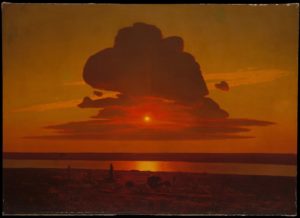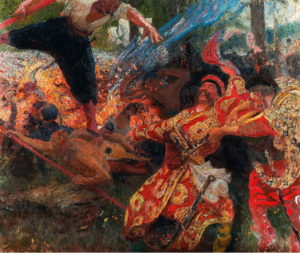Eleven Western countries are now sending tanks and other military equipment to Ukraine. Meanwhile, a seemingly unending amount of poorly-equipped Russian soldiers are pouring over the border. In the meantime, the Ukrainian people and Ukraine’s culture and national identity are becoming increasingly important players in the nearly year-long conflict. As a result, Western art institutions are starting to become more conscious of Ukraine’s contributions to the visual arts and try to understand how they became muddled or glossed over in the first place. Most recently, in what many call a significant step, New York’s Metropolitan Museum of Art has now categorized three prominent artists as Ukrainian after previously identifying them as Russian for years.
Ivan Aivazovsky, Arkhyp Kuindzhi, and Ilya Repin are three nineteenth-century painters previously identified as Russian by the Met who are now recognized as Ukrainian. All three were born in what is now Ukraine and had very different relationships with their respective identities. The most well-known of the three is Ilya Repin, mostly known for his realist paintings like They Did Not Expect Him, as well as historical scenes like Reply of the Zaporozhian Cossacks and Ivan the Terrible and His Son. While Repin self-identified as Russian because he was a subject of the Russian Empire, he frequently returned to Ukrainian subjects in his work, like village life, the cossacks, and the poetry of Taras Shevchenko.
Arkhyp Kuindzhi was mainly a landscape painter whose work was known for its incredibly expressive capturing of light in nature. His magnificent work Red Sunset on the Dnieper is the only Kuindzhi work in the Metropolitan Museum’s collections and the only one by any of the three artists currently displayed in the galleries. The painting shows the longest river in Ukraine, the River Dnieper (also called the Dnipro), which more recently has been fortified and helped Ukrainian forces keep Russian troops from advancing into the west of the country. Kuindzhi was a native of the city of Mariupol, the target of a nearly three-month Russian siege in 2022 that destroyed large swaths of the city. The Kuindzhi Museum, dedicated to the artist’s life and work, was destroyed in the siege.
Lastly, and probably the most complicated of the three, Ivan Aivazovsky was mainly a painter of landscapes, seascapes, and Orientalist scenes set in the Ottoman Empire. Because of the multiethnic nature of the Russian Empire, several groups often claim him as their own. Russia claims Aivazovsky because he was a subject of the Russian Empire and was identified as Russian abroad. Armenia claims Aivazovsky because he was born to ethnic Armenian parents. Ukraine claims Aivazovsky (and the Met concurs) because he was born in and spent much of his life in Ukraine. The ability of a single existing country to claim him today is incredibly complicated and contentious. Due to the circumstances of his birth and life, it is nearly impossible to place one of the most well-known painters to come out of the Russian Empire in the nineteenth century into a neat, little box of one country or another. No one side is completely in the right, but none of them are wrong either.
When London’s National Gallery of Art decided to change the name of a Dégas pastel work from Russian Dancers to Ukrainian Dancers last April, for the first time, many became aware of how Russia in all its forms has not only politically but culturally dominated Eastern Europe and the Slavic world for centuries. An independent Ukraine has only existed since the 1990s, but that nation wasn’t simply invented out of whole cloth right then and there. The Soviet Union and the Russian Empire that preceded it were enormous, multiethnic states where large national groups like Russians and Ukrainians shared a country with smaller ethnicities like Armenians, Moldovans, and Latvians. Therefore many of these less-populous nations were grouped under the “Russian” umbrella, with Russia claiming not only these artists’ works but even their nationalities and identities. Many artists who were born and worked in the Russian Empire were often identified as Russian by Western art historians and cultural institutions regardless of where they were from or how they themselves identified. So even if it may not seem like much, changing a few words on a painting’s information card recognizing an artist as Ukrainian restores not just a small piece of cultural heritage but a sense of pride and accomplishment to a nation that for centuries had been swept under the rug and forgotten.


